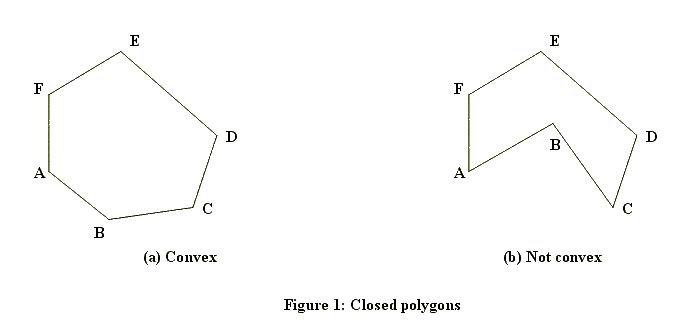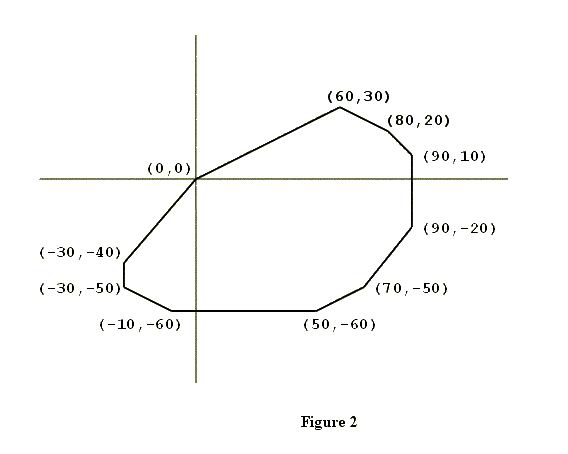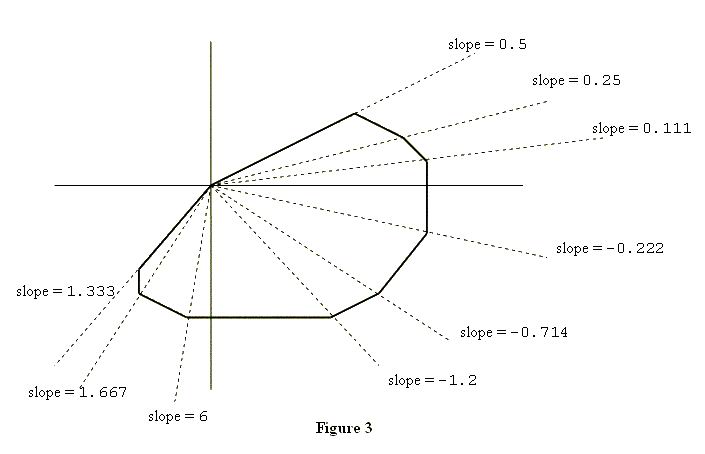poj2007 Scrambled Polygon (叉积极角排序)
2015-10-09 20:25
459 查看
题目链接:
http://poj.org/problem?id=2007
Scrambled Polygon
Description
A closed polygon is a figure bounded by a finite number of line segments. The intersections of the bounding line segments are called the vertices of the polygon. When one starts at any vertex of a closed polygon and traverses each bounding line segment exactly
once, one comes back to the starting vertex.
A closed polygon is called convex if the line segment joining any two points of the polygon lies in the polygon. Figure 1 shows a closed polygon which is convex and one which is not convex. (Informally, a closed polygon is convex if its border doesn't have
any "dents".)

The subject of this problem is a closed convex polygon in the coordinate plane, one of whose vertices is the origin (x = 0, y = 0). Figure 2 shows an example. Such a polygon will have two properties significant for this problem.
The first property is that the vertices of the polygon will be confined to three or fewer of the four quadrants of the coordinate plane. In the example shown in Figure 2, none of the vertices are in the second quadrant (where x < 0, y > 0).
To describe the second property, suppose you "take a trip" around the polygon: start at (0, 0), visit all other vertices exactly once, and arrive at (0, 0). As you visit each vertex (other than (0, 0)), draw the diagonal that connects the current vertex with
(0, 0), and calculate the slope of this diagonal. Then, within each quadrant, the slopes of these diagonals will form a decreasing or increasing sequence of numbers, i.e., they will be sorted. Figure 3 illustrates this point.


Input
The input lists the vertices of a closed convex polygon in the plane. The number of lines in the input will be at least three but no more than 50. Each line contains the x and y coordinates of one vertex. Each x and y coordinate is an integer in the range -999..999.
The vertex on the first line of the input file will be the origin, i.e., x = 0 and y = 0. Otherwise, the vertices may be in a scrambled order. Except for the origin, no vertex will be on the x-axis or the y-axis. No three vertices are colinear.
Output
The output lists the vertices of the given polygon, one vertex per line. Each vertex from the input appears exactly once in the output. The origin (0,0) is the vertex on the first line of the output. The order of vertices in the output will determine a trip
taken along the polygon's border, in the counterclockwise direction. The output format for each vertex is (x,y) as shown below.
Sample Input
Sample Output
题目大意:
给你几个点让你以原点为起点,逆时针输出这几个点。直接进行叉积极角排序即可,可是我以前没学过叉积,就找资料恶补了一下。 <strong><span style="font-size:18px;"> 向量的叉积可以用来判断点在直线的某侧。进而可以解决点是否在三角形内,两个矩形是否重叠等问题。向量的叉积的模表示这两个向量围成的平行四边形的面积。
设矢量P = ( x1, y1 ),Q = ( x2, y2 ),则矢量叉积定义为由(0,0)、p1、p2和p1+p2所组成的平行四边形的带符号的面积,即:P×Q = x1*y2 - x2*y1,其结果是一个伪矢量。
显然有性质 P × Q = - ( Q × P ) 和 P × ( - Q ) = - ( P × Q )。
叉积的一个非常重要性质是可以通过它的符号判断两矢量相互之间的顺逆时针关系:
若 P × Q > 0 , 则P在Q的顺时针方向。
若 P × Q < 0 , 则P在Q的逆时针方向。
若 P × Q = 0 , 则P与Q共线,但可能同向也可能反向。
叉积的方向与进行叉积的两个向量都垂直,所以叉积向量即为这两个向量构成平面的法向量。
如果向量叉积为零向量,那么这两个向量是平行关系。
因为向量叉积是这两个向量平面的法向量,如果两个向量平行无法形成一个平面,其对应也没有平面法向量。所以,两个向量平行时,其向量叉积为零。</span></strong>AC代码:
#include<iostream>
#include<stdio.h>
#include<cmath>
#include<complex>
#include<algorithm>
#define max(a,b) (a)>(b)?(a):(b)
#define min(a,b) (a)<(b)?(a):(b)
#define EPS 1e-8
using namespace std;
struct point {
double x,y;
};
point convex[50];
double cross(const point &p1, const point &p2, const point &q1, const point &q2)
{
return (q2.y - q1.y)*(p2.x - p1.x) - (q2.x - q1.x)*(p2.y - p1.y);//求叉积
}
bool cmp(const point &a, const point &b)
{
point origin;
origin.x = origin.y = 0;
return cross(origin,b,origin,a) < 0;//这里是叉积小于0的返回
}
int main()
{
int cnt = 0;
while (scanf("%lf%lf",&convex[cnt].x,&convex[cnt].y) != EOF) {
++cnt;
}
sort(convex+1,convex+cnt,cmp);
for (int i(0); i<cnt; ++i) {
cout<<"("<<convex[i].x<<","<<convex[i].y<<")"<<endl;
}
return 0;
}
http://poj.org/problem?id=2007
Scrambled Polygon
| Time Limit: 1000MS | Memory Limit: 30000K | |
| Total Submissions: 7648 | Accepted: 3641 |
A closed polygon is a figure bounded by a finite number of line segments. The intersections of the bounding line segments are called the vertices of the polygon. When one starts at any vertex of a closed polygon and traverses each bounding line segment exactly
once, one comes back to the starting vertex.
A closed polygon is called convex if the line segment joining any two points of the polygon lies in the polygon. Figure 1 shows a closed polygon which is convex and one which is not convex. (Informally, a closed polygon is convex if its border doesn't have
any "dents".)

The subject of this problem is a closed convex polygon in the coordinate plane, one of whose vertices is the origin (x = 0, y = 0). Figure 2 shows an example. Such a polygon will have two properties significant for this problem.
The first property is that the vertices of the polygon will be confined to three or fewer of the four quadrants of the coordinate plane. In the example shown in Figure 2, none of the vertices are in the second quadrant (where x < 0, y > 0).
To describe the second property, suppose you "take a trip" around the polygon: start at (0, 0), visit all other vertices exactly once, and arrive at (0, 0). As you visit each vertex (other than (0, 0)), draw the diagonal that connects the current vertex with
(0, 0), and calculate the slope of this diagonal. Then, within each quadrant, the slopes of these diagonals will form a decreasing or increasing sequence of numbers, i.e., they will be sorted. Figure 3 illustrates this point.


Input
The input lists the vertices of a closed convex polygon in the plane. The number of lines in the input will be at least three but no more than 50. Each line contains the x and y coordinates of one vertex. Each x and y coordinate is an integer in the range -999..999.
The vertex on the first line of the input file will be the origin, i.e., x = 0 and y = 0. Otherwise, the vertices may be in a scrambled order. Except for the origin, no vertex will be on the x-axis or the y-axis. No three vertices are colinear.
Output
The output lists the vertices of the given polygon, one vertex per line. Each vertex from the input appears exactly once in the output. The origin (0,0) is the vertex on the first line of the output. The order of vertices in the output will determine a trip
taken along the polygon's border, in the counterclockwise direction. The output format for each vertex is (x,y) as shown below.
Sample Input
0 0 70 -50 60 30 -30 -50 80 20 50 -60 90 -20 -30 -40 -10 -60 90 10
Sample Output
(0,0) (-30,-40) (-30,-50) (-10,-60) (50,-60) (70,-50) (90,-20) (90,10) (80,20) (60,30)
题目大意:
给你几个点让你以原点为起点,逆时针输出这几个点。直接进行叉积极角排序即可,可是我以前没学过叉积,就找资料恶补了一下。 <strong><span style="font-size:18px;"> 向量的叉积可以用来判断点在直线的某侧。进而可以解决点是否在三角形内,两个矩形是否重叠等问题。向量的叉积的模表示这两个向量围成的平行四边形的面积。
设矢量P = ( x1, y1 ),Q = ( x2, y2 ),则矢量叉积定义为由(0,0)、p1、p2和p1+p2所组成的平行四边形的带符号的面积,即:P×Q = x1*y2 - x2*y1,其结果是一个伪矢量。
显然有性质 P × Q = - ( Q × P ) 和 P × ( - Q ) = - ( P × Q )。
叉积的一个非常重要性质是可以通过它的符号判断两矢量相互之间的顺逆时针关系:
若 P × Q > 0 , 则P在Q的顺时针方向。
若 P × Q < 0 , 则P在Q的逆时针方向。
若 P × Q = 0 , 则P与Q共线,但可能同向也可能反向。
叉积的方向与进行叉积的两个向量都垂直,所以叉积向量即为这两个向量构成平面的法向量。
如果向量叉积为零向量,那么这两个向量是平行关系。
因为向量叉积是这两个向量平面的法向量,如果两个向量平行无法形成一个平面,其对应也没有平面法向量。所以,两个向量平行时,其向量叉积为零。</span></strong>AC代码:
#include<iostream>
#include<stdio.h>
#include<cmath>
#include<complex>
#include<algorithm>
#define max(a,b) (a)>(b)?(a):(b)
#define min(a,b) (a)<(b)?(a):(b)
#define EPS 1e-8
using namespace std;
struct point {
double x,y;
};
point convex[50];
double cross(const point &p1, const point &p2, const point &q1, const point &q2)
{
return (q2.y - q1.y)*(p2.x - p1.x) - (q2.x - q1.x)*(p2.y - p1.y);//求叉积
}
bool cmp(const point &a, const point &b)
{
point origin;
origin.x = origin.y = 0;
return cross(origin,b,origin,a) < 0;//这里是叉积小于0的返回
}
int main()
{
int cnt = 0;
while (scanf("%lf%lf",&convex[cnt].x,&convex[cnt].y) != EOF) {
++cnt;
}
sort(convex+1,convex+cnt,cmp);
for (int i(0); i<cnt; ++i) {
cout<<"("<<convex[i].x<<","<<convex[i].y<<")"<<endl;
}
return 0;
}
相关文章推荐
- POJ ACM 1001
- POJ ACM 1002
- POJ 2635 The Embarrassed Cryptographe
- POJ 3292 Semi-prime H-numbers
- POJ 2773 HAPPY 2006
- POJ 3090 Visible Lattice Points
- POJ-2409-Let it Bead&&NYOJ-280-LK的项链
- POJ-1695-Magazine Delivery-dp
- POJ1523 SPF dfs
- POJ-1001 求高精度幂-大数乘法系列
- POJ-1003 Hangover
- POJ-1004 Financial Management
- 用单调栈解决最大连续矩形面积问题
- 2632 Crashing Robots的解决方法
- 1573 Robot Motion (简单题)
- POJ 1200 Crazy Search(简单哈希)
- 【高手回避】poj3268,一道很水的dijkstra算法题
- POJ 1088 滑雪
- poj2387 Til the Cows Come Home—Dijkstra模板
- poj 2485 Highways
